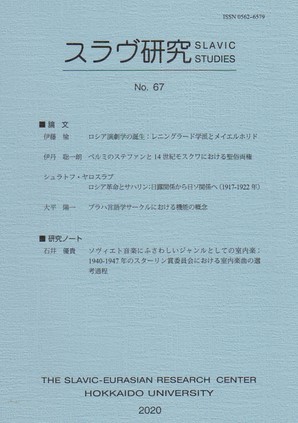プラハ言語学サークルにおける機能の概念
Prague School Functionalism in a Historical Context
Author(s): Yoichi OhiraSubject(s): Theoretical Linguistics, Aesthetics, Phonetics / Phonology, Historical Linguistics, Philosophy of Language, Interwar Period (1920 - 1939), Philology
Published by: Slavic Research Center
Keywords: Prague School Functionalism; function; roots and development of functionalism; PLC writings; language development; structural aesthetics; Mukařovský’s dynamic functional model;
Summary/Abstract: The “functional” attribute has been a characteristic feature of the Prague Linguistic Circle (PLC) since its inception. The term was chiefly recognized within the teleonomic frame of reference. The central members of the PLC featuring V. Mathesius, R. Jakobson, P. Bogatyrev, and J. Mukařovský were distinguished individuals with different academic interests and cultural backgrounds. While their conceptualizations of “function” accordingly reflect a great diversity of perspectives, specific differences among them can be identified on both the horizontal (between individuals) and vertical (the development of the opinions of individuals) axes. This article explores the roots and development of functionalism in the Prague school, addressing the various modes of its employment in linguistics, ethnography, and aesthetics. The term “function(al)” is ubiquitous in the entire writings of the Prague scholars. For instance, the opening paragraph of the first chapter of the “Thèses” presented by the PLC to the First Congress of Slavists in 1929 is titled “Conception de la langue comme système functional,” and the title of Chapter 9 reads “Importance de la linguistique fonctionelle.” Furthermore, the corresponding Czech term “funkční lingvistika” appears as the title of one of Mathesius’s essays from 1929 that explores the “functional” principle through a discussion of the common requirement for expression and communication, and subsequently investigates the means to satisfy them. To ascertain the precise notional interpretation of this term is a complex task, however. The reasons for this difficulty are manifold. First, almost no scholarly attempt has been made to define “function,” a pivotal concept in the writings of the Prague school. Second, as the concept was applied to multiple domains such as linguistics, ethnography, poetics, and aesthetics, it has inevitably undergone various modifications. Finally, one can identify differences and vacillations in various authors’ interpretation of the concept of “function.” The exploration of the usage of “function(al)” in the PLC writings requires an inquiry into the theoretical and philosophical background, as well as the inspiration that informs the systematic introduction of this concept into linguistic, ethnographic, and aesthetic debates. The dearth of direct references to relevant literature in prewar PLC writings confines our analysis to highlighting some possible influences from the works of Durkheim, Radcliffe-Brown, Engliš, Baudouin de Courtenay, and Tynjanov, among others. While J. Baudouin de Courtenay undoubtedly shaped Mathesius’s conceptualization of functionality, the latter was likely to be inspired by certain works of sociology, too. Jakobson, who arrived in Prague in 1920—several years before the formation of the PLC—was among central representatives of “Formalism” in Russia together with Tynjanov. With a teleological orientation in his writings of the Russian period, Jakobson was renowned for his detailed analysis of issues concerning Russian functional language, particularly his analysis of poetic language. Jakobson further developed the functional notion of “poetic language,” a characteristic feature of Russian Formalism, and incorporated it into his well-known six-function model. While Jakobson and Tynjanov coauthored a renowned thesis “Problems of Literary and Linguistic Studies,” Tynjanov’s mathematical model is in marked contrast to Jakobson’s conceptualization of “function.” In his Prague period Jakobson extended his functional explanations to the treatment of language development, focusing mainly on the domain of phonology toward the end of the 1930s. In 1927 he gave a lecture titled “The concept of the sound law and the teleological principle,” in which he presented the notion of a goal-directed interpretation. Characterized as a “therapeutic change,” the essence of this idea was that a system of language is always striving to balance its elements. In his American-period works, Jakobson increasingly attempted to underpin teleological concepts with references to philosophical and scientific thought contemporary of that time. Although Daneš underscores the diverging views on the notion of functionalism marked by Jakobson’s teleological and Mathesius’s common-sense approach, this divergence is actually less substantial than it may appear. Indeed, this divergence can be reconciled if we accept Pittendrigh’s suggestion that the new conception of finality be distinguished from the old, metaphysical idea of a final cause through the neologism “teleonomy.” As many functions of language (especially in the field of phonology) are unconscious, they cannot be simply understood with teleological (goal-intended) processes based on conscious ideas but must be explained as teleonomical (goal-directed) processes with no consciously acting, discernible actor.
Journal: Slavic Studies
- Issue Year: 2020
- Issue No: 67
- Page Range: 83-114
- Page Count: 32
- Language: Japanese

